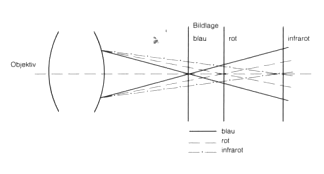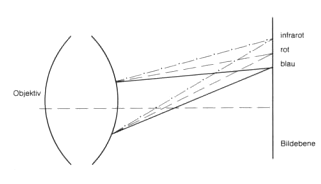Color errors in lenses
Color errors are caused by the fact that the refractive index of optical glasses is different for different wavelengths (colors). This phenomenon is known as dispersion. There are two classes of chromatic aberration.
Color errors are caused by the fact that the refractive index of optical glasses is different for different wavelengths (colors). This phenomenon is known as dispersion. There are two classes of chromatic aberration.
This causes the image position to vary for different wavelengths (colors) of light. Since the image sensor can only assume a certain position, this results in a blurred image. If two extreme wavelength ranges are used in succession, e.g. visible light and infrared radiation, either refocusing or a considerable loss of sharpness must be accepted. Figure 1 illustrates this.

Figure 1: The longitudinal color aberration
Lateral chromatic aberration manifests itself as a shift of the entire beam and thus of the pixel for different wavelengths (colors) of the radiation. For color cameras, this leads to colored stripes at the edges, and for black-and-white cameras, to blurred edges (Fig. 2).
Color aberrations can be reduced by using special optical glasses called "ultra low dispersion" glasses (more precisely, glasses with anomalous partial dispersion).

Fig. 2: The lateral chromatic aberration
Please do not hesitate to contact us if you have any questions. Our dedicated team is here to help you every step of the way. Whether you need assistance with product selection, technical specifications, or general inquiries.
Jos. Schneider Optische Werke GmbH
Ringstraße 132
55543 Bad Kreuznach | Germany
Tel: +49 (0) 671 601 205
isales(at)schneiderkreuznach.com
Contact form